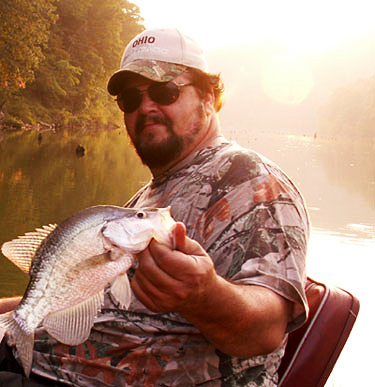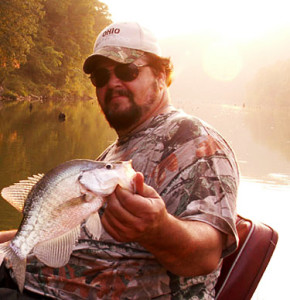
By Chris Erwin
Last week, I had the pleasure of riding along with the DFWL to document the Habitat project on Cave Run Lake. On Wednesday, once we worked into the afternoon; it was time for me to head out. I had my family drop me off with my boat on the main lake, and they headed back to Ashland to keep the upholstery shop open. I was to head up the river to our fish camp and stay there the rest of the week.
This gave me a chance to do some exploring and time to try a few things that are hard to do when you are there for just one or two days. I started back up the river about 2 pm. This is about a 12-mile trip through what many would call dangerous water, full of stumps; tree tops many spanning the girth of the river.

While this may be a bottom thumping affair for many people, for the last 30 years, I have been running this river from the main lake to Black Water and to Northfork to my fish camp. I stopped a few places along the way to sample the fishing. However, it was hot and the sun was providing very little shade this time of day, so I fire up the big engine and ran back to Northfork and jump on a four-wheeler I have left where I could walk to it and then ride to the camp that over-looks the river.
My plan was to eat a bite and head back out on the water once the sun goes down enough to create shade along the bank line. That evening I fished for bass, catching a hand full of slot fish (13-16 inches). The next morning, I planned to get up early and hit the flats to try to catch a muskie. That plan didn’t produce a muskie, but I did manage to catch a few more bass, and one of the side effects puts me on a pattern I didn’t know existed.
I keep a crappie rod rigged in my boat all the time. This rod was pieced together, and it’s too long to go in my rod-locker. When I’m casting the bank or down trees, and I see a place I think might hold crappie; I cast it into the area work the jig a few times and then move on to the next place. While doing this, I started catching good crappie in the standing channel trees.
Once I started catching crappie on more than one tree, and the sun was starting to reduce my success on the flats. I turn my full attention to fishing the crappie rig.
After some tweaking, I realized I needed to be on channel trees were only the stumps were visible once you could see down into the water; very few fish were coming from trees that were sticking out of the water. I also noticed that I was having better success fishing a 32/oz. jig dressed with a straight tailed grub, dressed with two Berkley Crappie nibbles covering the hook. This rig didn’t need to be jigged or moved. They wanted it to be dead still. One time after another my crappie rod would bounce, and I would set the hook and a good crappie most of these fish were 9-10 inches not giants but good eating size fish.
The tree tops were in about 12 to 15 feet of water, and the crappie was near the bottom. This pattern held up the whole time I was on the water. What was good about this pattern was it would catch fish in the heat of the day when the bass and muskie were hard to catch.
If you get on the water you might give it a try this pattern should hold up until fall. Chris Erwin is the founder and publisher of Kentucky Angling News an on-line magazine available at www.kentuckyangling.com/magazine Chris can be reached by email chris@ashlandbeacon.com


Be the first to comment